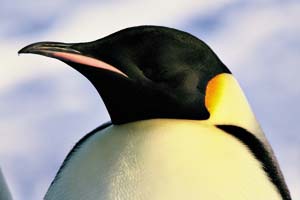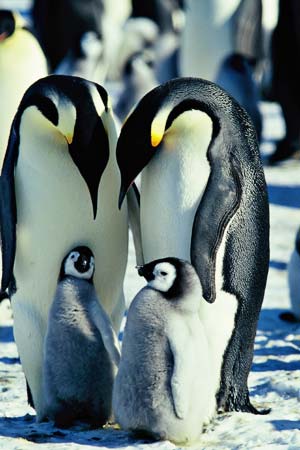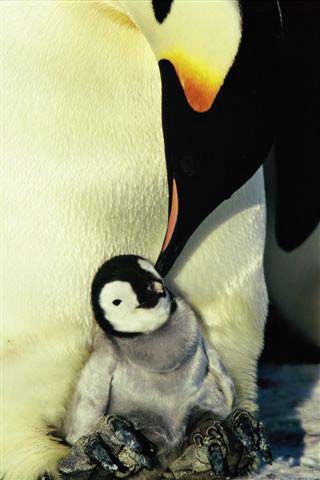March of the Penguins
Air Date: Week of July 16, 2005

(Photo: Jérôme Maison. © 2005 Bonne Pioche Productions / Alliance De Production Cinématographique)
The documentary "March of the Penguins" has become a surprise hit among moviegoers this summer. Host Steve Curwood talks with Sea World bird curator Lauren DuBois about the appeal of these Antarctic waddlers, and about the almost impossible journey they take to make a family. (Photo: Jérôme Maison. © 2005 Bonne Pioche Productions / Alliance De Production Cinématographique)
Transcript
CURWOOD: There's one nature film that's making a surprise splash in theatres these days. "March of the Penguins" is a documentary by filmmakers who spent more than a year tracking the birds along their seasonal migration across Antarctica. And although the journey itself is a miracle of science, it’s the story of just two penguins that has captured the heart of summer moviegoers.
[DRAMATIC MUSIC SWELLS]
TRAILER: In the harshest place on earth, love finds a way. This is the incredible true story of a family's journey to bring life into the world.
[PENGUIN CALLS, MUSIC]

(Photo: Jérôme Maison. © 2005 Bonne Pioche Productions / Alliance De Production Cinématographique)
CURWOOD: And here to talk with me about the stars of the movie is Lauren DuBois.
She's assistant curator of birds at Sea World in San Diego, and is a big fan of the film's emperor penguins. So much so that you've seen the movie twice, is that right?
DUBOIS: That is correct, and I'll probably see it a third time, as well.
CURWOOD: [LAUGHS] Okay. What do you think is the appeal of this nature documentary versus others in the past? I mean, I'm told that in the theatres where it's playing now, it's actually outselling blockbusters like “War of the Worlds” and “Batman Begins.” I mean, how do you think it is that a nature film is making such an unprecedented showing?
DUBOIS: Well, of course, working with penguins I can always say that penguins have a big appeal, but I think really the life history of the emperor penguins is so fascinating, and because they're found in such a remote area that nobody has really heard the story before. So penguins, a lot of people equate to looking like people. As you see them, really one of the first opening shots of the movie is, you see these figures walking along the ice, and they look like people walking along a trail. And when you get up closer, you realize “oh my goodness, these are not people, these are animals, and beautiful penguins, making this tremendous trek to go find a mate to breed, to have chicks,” and it's something that in a way I think we can all sort of appeal to. We all want some sort of companionship, we all want to be, you know, in a large group of people sometimes. And I think that's one of the appeals. And when you have all these other movies that have all these big flashy bombs going off and things like that, you have something that's very simple, and very, kind of back down to earth, and take a look at something that's just wonderful.
CURWOOD: We have another clip from the movie that we'd like to play now.
[MUSIC FADES UP, SOUNDS OF WATER]
MOVIE NARRATOR: It is March. Summer is over, and another long polar winter is about to begin. The birds have been feeding on the ocean water for three months. Now, their bellies full, it is time to find a mate.
[MUSIC FADES OUT]
|
CURWOOD: Lauren DuBois, what does it take for these penguns to find a mate and start a family? DUBOIS: Oh, it takes a tremendous amount. They have to--one, travel almost 70 miles to their breeding grounds. And that's a very long walk, or a very long toboggan. And once they get there, they have to find the perfect mate. Females are actually looking for a male that's fairly large, and is going to be able to sustain close to two months sitting on an egg. And it takes a lot of sort of competing and looking just for the right mate to be able to know that bird is going to be able to survive a very harsh winter, while she takes off. And when she comes back, she's going to be wanting to have that mate that's going to come back to help her raise that chick. CURWOOD: And the biggest guys win? DUBOIS: And the biggest guys win. Isn't that unusual? You know, instead of looking for that slim, trim Mr. Muscle, they're looking for that rather chubby guy that's going to be able to sustain an entire winter in harsh conditions: 100 mile winds, minus 50 degrees, so yeah, she wants that big portly guy. CURWOOD: [LAUGHS] And there's this moment in the movie where the penguin family is finally together for the first time, and I want to play a little bit of this right now. [PENGUIN CALLS FADE UP] MOVIE NARRATOR: The couple has found one another. The mother sees her chick for the first time and at last, the family is together. [MUSIC FADES OUT] CURWOOD: Lauren, what are the images that you remember of the scene? And I'm wondering, what might this scene tell us of the species as a whole? DUBOIS: Well, it's funny because I can see that image and that whole scene very vividly where it's the recognition of the chick, and both of them are sort of recognizing, “yes, this is what we've sort of been, this is what I've incubated and this is why you came back.” And there's this chick, and the chick is just beautiful, you can't imagine how beautiful these chicks are. And it goes out, and who knows, in five or seven years, that chick's going to come back to that same area and do the same thing and start the whole cycle over again. It's just incredible.  (Photo: Jérôme Maison. © 2005 Bonne Pioche Productions / Alliance De Production Cinématographique) |
CURWOOD: Lauren DuBois is assistant curator of birds at Sea World in San Diego. Lauren, thanks for taking this time with me today. DUBOIS: You're welcome, it was my pleasure. [MUSIC] CURWOOD: We leave you this week in the land of the penguin. Douglas Quin recorded these sounds in, under and around the icy waters of Antarctica’s Weddell Sea. [EARTHEAR: “Weddel Space” from‘The Dreams Of Gaia’ recorded by Douglas Quin (EarthEar - 1999)] Living on Earth wants to hear from you!Living on Earth Newsletter [Click here]
Donate to Living on Earth! NewsletterLiving on Earth offers a weekly delivery of the show's rundown to your mailbox. Sign up for our newsletter today!
|






